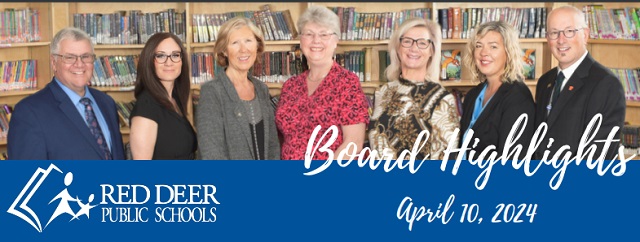Education
RDC – Partnerships enhance program opportunities

At Red Deer College, we are very proud of the breadth of more than 100 programs that we offer. In my column in June, I shared details about how we are launching seven new programs this academic year, which positively enhances the scope of our offerings.
While we often talk about programs at a high level, today I would like to share with you specific examples about what opportunities within our programs looks like for students on a day-to-day basis. This is the more personal side to our programming, because it involves the experiences, relationships and learnings that can have lifelong impacts on our students. The examples I will discuss are possible thanks to the strong partnership that Red Deer College has with Red Deer Public School District (RDPSD).
Last year, our two organizations entered into agreement that, in its most functional way, could be described as trading spaces to enhance learning opportunities. In September 2017, Red Deer Public School District began using a classroom at RDC for the new College High School, which provides an alternative site for high school students to complete their education here at RDC.
And starting in September 2019, RDC students in the School of Education will benefit from a dedicated, flexible learning space, as well as learning opportunities in the new Westpark Middle School, which is currently under construction.
But this partnership is about so much more than just spaces in which to learn. Thanks to our partnership – and under the leadership of Gloria Antifaiff, Dean of RDC’s School of Education, along with Della Ruston, Associate Superintendent, System Services with RDPSD, and Dean Pasiuk, Principal at Westpark Middle School – we had the opportunity to dream big. We collaborated to determine what the areas of need were, and we looked at creative ways we could work together to best serve our students of all ages.
We are so encouraged by the successes so far. With the College High School, students are taking their high school courses at RDC, and this offers them the opportunity they might not otherwise have had to attain their high school diplomas. These students may have left high school early and are now looking to complete, or the high school environment may not be the right fit for them to be successful in their studies.
Now, thanks to the College High School, they can complete their courses at Red Deer College, taught by a teacher employed by RDPSD, and they can become familiar with and confident in the College environment. While completing their high school courses, they are also exposed to what post-secondary education looks like, and this opens the door for many new possibilities for their futures.
As we look to the future starting next September, we are so excited for what the opportunities at Westpark Middle School will mean for our RDC students in the School of Education. The dedicated classroom space and immersion within the school setting will provide our students with a real-time learning lab in a safe, supportive environment.
Our plan for this space in Westpark Middle School is to deliver a required course that all Bachelor of Education students have to take in either their first or second year. This will allow them to become familiar with and comfortable in a school setting very early in their academic program. They will be able to start building a toolbox of strategies that will help them as future teachers, and they will learn how to interact with students and staff through their coursework and other potential volunteer opportunities. In addition, we are also exploring ways to incorporate this type of experiential learning into the Educational Assistant program.
This is a unique model within a middle school setting, and it is an example of workplace integrated learning, which will be an important part of RDC’s future programming as a comprehensive regional teaching university.
These positive learning opportunities are only possible because of our strong partnership and the support, dedication and commitment from both Red Deer Public School District and Red Deer College. We are all extremely passionate about teaching and learning, and this has been a wonderful opportunity for our organizations – located just across the street from each other – to partner for the benefit of our community members and our students.
Dr. Paulette Hanna is Vice President Academic at Red Deer College.
This column was first published in Red Deer Advocate on Saturday, September 29, 2018.
Education
Solar eclipse school closures underscore impact of learning loss

From the Fraser Institute
Instead of making every effort to protect instructional time and ensure that schools remain open, students are being sent home for ever more dubious reasons.
Schools are closed out of an “abundance of caution.” No doubt you’ve heard this phrase many times over the last few years. It was commonly used during the pandemic when provincial governments closed schools for months on end—even after it was widely known that COVID-19 posed little risk to most children.
Ontario schools were closed for 135 days during the pandemic, more than any other province. Parents and teachers are still trying to recover from this enormous learning loss. Clearly, this was one situation where an abundance of caution caused more harm than it prevented.
Sadly, it appears that provincial officials and school board administrators haven’t learned from their mistakes. Instead of making every effort to protect instructional time and ensure that schools remain open, students are being sent home for ever more dubious reasons.
For example, school boards across Ontario cancelled classes on April 8, the day of the solar eclipse. Apparently administrators felt there was too great a risk that students might look at the sun during the eclipse and damage their eyes. No doubt more than a few of them glanced at the sun while sitting at home that day. However, there was no need for the school closures to be as total as the eclipse. If they were really that concerned, school officials could have kept students indoors or simply altered the dismissal times.
Initially, the Waterloo Region District School Board (WRDSB) took a common sense approach by stating that schools would remain open and teachers would use the eclipse as a learning opportunity for students. Then, only days before the eclipse, the WRDSB suddenly reversed itself and said their schools would indeed close on April 8, and students would have the opportunity to engage in “asynchronous remote learning” instead.
This decision sent the unfortunate message that WRDSB trustees are incapable of standing up to pressure from people who think that schools must close at the slightest sign of real or presumed danger. As for the notion that remote learning was an adequate substitute, our experience during the pandemic showed that for most parents and students, remote learning was thin gruel indeed.
As a further sign of how far paranoia has crept into the education system, some teacher unions demanded they too should be able to work from home during the eclipse. For example, Jeff Sorensen, president of the Hamilton local teacher union, said, “If it’s not safe for children [to be at school], then it’s not safe for adults.”
The union representing Toronto’s Catholic teachers made a similar request. In a memo to its members, local union president Deborah Karam said the union was “intensifying our efforts” to ensure that teachers be allowed to complete their professional development activities at home that day. Surprisingly, no union leader has yet explained why teachers would be less likely to look at the sun while at home than at school.
Of course, school boards must focus on education while also looking out for the wellbeing of students. But there’s more to student wellbeing than simply shielding them from all perceived risks. Extended school closures cause considerable harm to students because they lead to significant learning loss.
By normalizing the practise of closing schools at the slightest sign of danger, real or perceived, we risk raising a generation of young people who lack the ability to do a proper risk assessment. Life itself comes with risk and if we all took the same approach to driving a car that school boards take to school closures, would never set foot in a vehicle again.
Ontario students had a once-in-a-lifetime opportunity to experience a solar eclipse in an educational environment, guided by their teachers. While some parents no doubt taught their children about the eclipse, many others had to be at work.
By closing schools out of an “abundance of caution,” school boards sent the message that school is not a place where unique educational events can be experienced together. Students should be in school during events such as the eclipse, not sitting at home.
If we’re going to exercise an abundance of caution, let’s be a lot more cautious about the risks of closing schools at the drop of a hat.
Author:
Education
Red Deer Public Schools facing million dollar deficit due to inflation and carbon tax

Draft Three Year Education Plan
While the full Division Three-Year Education Plan will be presented to the Board next month, in order to facilitate strategic planning at both the school and Division levels, the Board was presented with the
proposed Strategies and Performance Measures that will set the strategic direction for Red Deer Public Schools in the coming years.
The highest priority for the Division is the success of every student. For the upcoming school year we have organized our strategic work around the following Alberta Education Assurance Domains:
- Student Growth & Achievement
- Teaching and Leading
- Learning Supports
- Governance
The fifth Alberta Education Assurance Domain, Local and Societal Context, encompasses all of the
aforementioned areas. Ten proposed strategies, which will be used to guide Red Deer Public‘s work, as well as 14 proposed performance measures, were also presented. PLAN
Budget Review and Schedule
Red Deer Public Schools is in the process of reviewing its budget for the 2024/2025 school year.
The Division’s budget totals $131 million. With a current projected deficit of $1 million, the state of the Division’s reserves will be about $2.8 million as of Aug. 31, 2024 year end.
Projected student enrolment is also similar for the 2024/2025 school year at about 10,800 FTE students. One challenge this year is that there has not been additional funding provided for inflationary cost increases such as benefit costs, carbon tax, supplies and materials and utilities.
The Board is expected to approve the 2024/2025 budget on May 8, with submission to Alberta Education on May 31. BUDGET
Field Studies Approved
The Board of Trustees approved two Field Studies for students at Hunting Hills High School and Gateway Christian School.
Hunting Hills students enroled in the Chinese Language and Culture courses will travel to China in April 2025. Students will be immersed in the Chinese language and learn to appreciate Chinese culture.

As well, in April 2025, students part of the Co-Impact Team from Gateway Christian School will travel to the Dominican Republic to take part in a number of service activities.
-

 Alberta2 days ago
Alberta2 days agoFree Alberta Strategy backing Smith’s Provincial Priorities Act
-

 Business2 days ago
Business2 days agoUS firms like BlackRock are dropping their climate obsession while Europe ramps theirs up
-

 Automotive2 days ago
Automotive2 days agoBiden’s Kill Switch: The Growing Threat of Government Control of Your Car
-

 espionage1 day ago
espionage1 day agoTrudeau’s office was warned that Chinese agents posed ‘existential threat’ to Canada: secret memo
-

 COVID-191 day ago
COVID-191 day agoPro-freedom Canadian nurse gets two years probation for protesting COVID restrictions
-

 Economy1 day ago
Economy1 day agoMassive deficits send debt interest charges soaring
-

 International17 hours ago
International17 hours agoBrussels NatCon conference will continue freely after court overturns police barricade
-

 Business17 hours ago
Business17 hours agoFederal budget fails to ‘break the glass’ on Canada’s economic growth crisis







